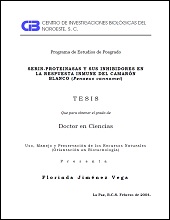Serin-proteinasas y sus inhibidores en la respuesta inmune del camarón blanco (Penaeus vannamei)
Resumen
Los camarones son organismos capaces de combatir exitosamente a los patógenos. Aunque la especificidad de su sistema inmune parece estar limitada, son capaces de diferenciar lo propio y lo extraño, respondiendo a través de mecanismos celulares y humorales, los cuales pueden combinarse para constituir sistemas multiméricos, como el sistema de activación de la profenoloxidasa (proFO) y el sistema de coagulación. Ambos sistemas están constituidos por cascadas enzimáticas donde las proteinasas tienen un papel decisivo en la activación. Sin embargo, la actividad proteolítica debe ser mantenida dentro de parámetros fisiológicos para evitar daños tisulares. Por ello, las proteinasas y sus inhibidores, han sido considerados como parte importante en el control de la respuesta inmune. Utilizando macroarreglos de un banco de cDNA de hemocitos de camarón, fue posible la identificación de clones codificantes para serin proteinasas, inhibidores tipo Kazal y proteínas tipo WAP. Los insertos fueron secuenciados y se buscó establecer variaciones en su expresión en respuesta a la inoculación de Vibrio alginolyticus. Además del dominio proteolítico, las serin proteinasas de hemocitos de crustáceos, característicamente, contienen un dominio llamado clip. Se encontró un clon codificante para una serin proteinasa que contiene un dominio clip incompleto, el cual es similar a otros reportados en insectos. Del mismo modo, se caracterizó el inserto de un clon conteniendo la región codificante parcial para otra serin-proteinasa, la cual tiene Gly en lugar de Ser en su sitio catalítico. Este tipo de serin proteinasas homólogas han sido reportadas en artrópodos. Los inhibidores de proteinasas del tipo Kazal han sido descritos como proteínas de bajo peso molecular caracterizados por un dominio de 6 cisteínas. Las proteínas pueden contener varios dominios, aunque no todos con actividad inhibitoria [...] The shrimps are able to destroy successful pathogen. Although the specificity of the immune system appears be limited, they can distinguish self and non-self material and to establish a response through cellular and humoral mechanisms, which can constitutes multimeric systems, as those responsible to prophenoloxidase (proFO) activation and coagulation. Both systems are constituted by enzymatic cascades were the proteinases plays an important role in their activation. However, the proteolytic activity has to be kept into physiological levels in order to avoid tissue damage. By this, proteinase and their inhibitors have been considered as important component on the immune response regulation. Using macroarrays, from a cDNA library of shrimp hemocytes, several clones encoding for serine-proteinase, Kazal inhibitors and WAP-containing protein were identified. The insert was sequenced and changes in expression as response to Vibrio alginolyticus inoculation were investigated. Beside the proteolytic domain, the serine-proteinase from crustacean hemocytes characteristically contains an additional domain, called clip. A clone contained an insert encoding to a serine proteinase was found. However, this protein contains an incomplete clip domain, similar to other reported in insects. A clone encoding for other serine proteinase was also isolated. Such deduced protein has Gly instead Ser in the active site. This kind of serine proteinase homologs has been also reported in arthropods. Kazal proteinase inhibitors have been described as low molecular weight proteins containing one or more typical domains characterized by a 6 cysteins core. Although multiple domains can be present, not necessarily all have inhibitory activity [...]

